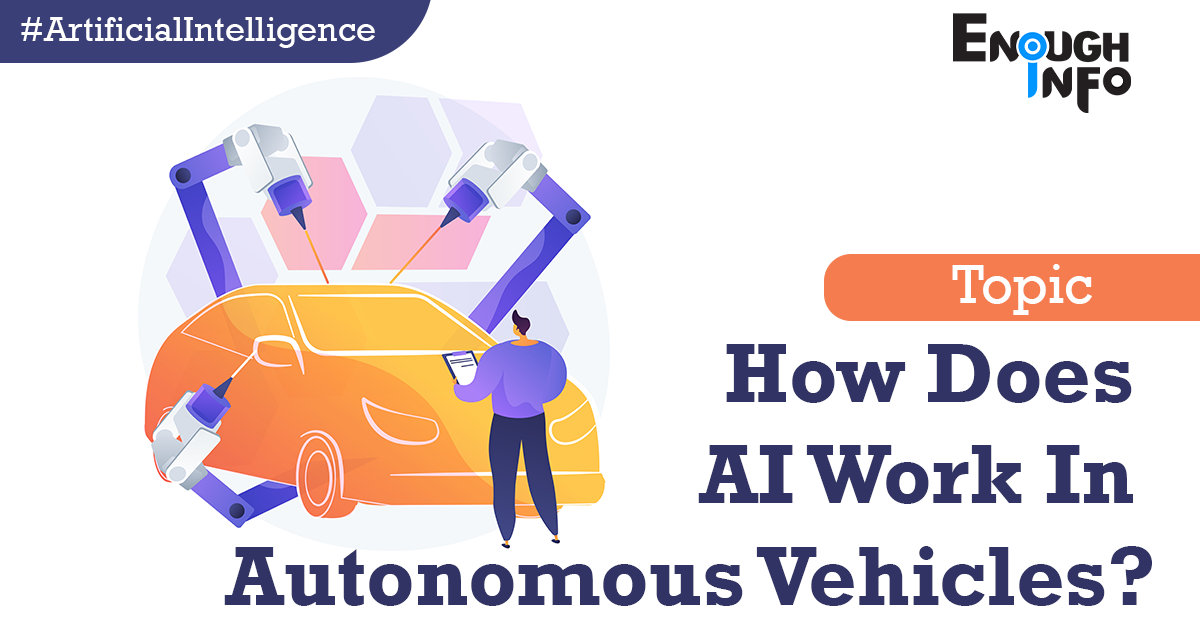How Does AI Work In Autonomous Vehicles?

How Does AI Work In Autonomous Vehicles?: AI makes autonomous vehicles (AVs) work without humans. Sensors, computers, and software help AVs perceive and make choices. AI analyses sensor data, controls the vehicle, and makes judgements. But the real question is on how AI works on autonomous vehicles. Keep Scrolling. EnoughInfo.com

Read Also: How AI and Nanotechnology Work Together
FAQs & Answers on How Does AI Works In Autonomous Vehicles?
1. How do autonomous vehicles learn and improve over time?
Autonomous vehicles use machine learning algorithms to learn from past experiences and improve their performance over time. They can also be trained through simulation testing to prepare them for a wide range of scenarios.
2. How safe are autonomous vehicles?
Autonomous vehicles are designed with safety in mind, and developers are constantly working to improve their safety features. However, accidents involving autonomous vehicles have occurred, highlighting the need for continued research and development in this area. How To Treat Periodic Limb Movement Disorder
3. How will autonomous vehicles impact the job market?
Autonomous vehicles may have a significant impact on the job market, particularly for jobs related to transportation and logistics. While some jobs may be replaced by automation, new jobs may also be created in areas such as vehicle maintenance and software development.
Read Also: How Consensus Mechanism Works In Blockchain
How Does AI Work In Autonomous Vehicles?
The use of AI in AVs has the potential to revolutionize transportation by making it safer, more efficient, and more accessible. Self-driving cars have the potential to reduce accidents caused by human error, improve traffic flow by reducing congestion, and provide mobility options to people who are unable to drive due to disabilities or age. How To Stop Feeling Insecure About Your Body
AI in AVs is a rapidly evolving field, with many automotive manufacturers and tech companies investing heavily in research and development. However, there are still many challenges that need to be overcome, such as regulatory and safety issues, before fully autonomous vehicles become a widespread reality. How To Get Rid Of Rust (8 Good Methods)
A Brief History On AI On Autonomous Vehicles
The idea of autonomous vehicles dates back to the 1920s when the first prototypes of self-driving cars were developed. However, it was not until the development of artificial intelligence in the 1950s that the concept of autonomous vehicles began to gain serious traction.
Here’s a brief history of the development of AI on autonomous vehicles:
DARPA Grand Challenge:
In 2004, the Defense Advanced Research Projects Agency (DARPA) held the first Grand Challenge for autonomous vehicles. The challenge required teams to build self-driving vehicles that could navigate a 142-mile course through the Mojave Desert. None of the teams were able to complete the course, but the event marked a significant milestone in the development of autonomous vehicles.
Google’s Self-Driving Car:
In 2009, Google began work on a self-driving car project, which would later become Waymo. The company used a combination of lidar, radar, and cameras to develop a system that could navigate city streets and highways. How To Be A Man
Tesla Autopilot:
In 2014, Tesla introduced Autopilot, a semi-autonomous driving system that uses cameras and radar to steer the vehicle, control its speed, and change lanes. Tesla’s Autopilot system was one of the first examples of AI being used in mass-produced vehicles.
Read Also: How To Precondition Tesla Battery
Current State:
Today, many automotive manufacturers and tech companies are investing heavily in autonomous vehicle development. Companies such as Waymo, Cruise, and Aurora are developing fully self-driving cars that can operate without human intervention.
The development of AI in autonomous vehicles has come a long way in the past few decades, and the technology is rapidly advancing. While there are still challenges to overcome, such as safety and regulatory issues, the future looks promising for self-driving cars.
The Growth of AI In Autonomous Vehicles (AV)
The growth of AI in autonomous vehicles has been significant in recent years, with advances in sensor technology, machine learning, and computer processing power driving the development of more sophisticated self-driving cars. Companies are investing heavily in AV research and development, with over $50 billion invested in AV technology in 2020 alone. With continued technological progress, we can expect to see more sophisticated and safer self-driving cars on our roads in the future.
Here are some more detailed key developments that demonstrate the growth of AI in autonomous vehicles:
1. Deep learning
One of the most significant developments in AI in recent years has been the rise of deep learning, a type of machine learning that uses artificial neural networks to analyze large datasets. Deep learning has been particularly effective in improving the accuracy of object recognition in autonomous vehicles, allowing AVs to better understand and respond to their environment.
2. Advanced sensor fusion
Autonomous vehicles use a variety of sensors to perceive their environment, including cameras, lidar, radar, and ultrasonic sensors. Advanced sensor fusion techniques enable AVs to combine data from multiple sensors to create a more complete understanding of their surroundings. This improves the accuracy of object recognition and helps AVs make more informed decisions about how to navigate their environment.
Read Also: How To Use A Jump Starter (Step by Step)
3. Simulation testing
Testing autonomous vehicles on public roads can be dangerous and expensive. To overcome this, many companies are using simulation testing to train and test their AVs in virtual environments. Simulation testing allows AV developers to create a wide range of scenarios and test their algorithms in a safe and controlled environment, accelerating the development and testing process.
4. Improved safety features
Safety is a critical concern for autonomous vehicles, and many companies are developing advanced safety features to ensure the safety of passengers and pedestrians. For example, some AVs are equipped with lidar systems that can detect and respond to emergency situations, such as a pedestrian stepping into the road unexpectedly.
5. Open-source software
The development of open-source software has also been instrumental in the growth of AI in autonomous vehicles. Open-source software allows developers to share code and collaborate on projects, accelerating the development process and driving innovation in the field.
Overall, these key developments demonstrate the significant growth of AI in autonomous vehicles in recent years. As technology continues to evolve, we can expect to see even more sophisticated autonomous vehicles on our roads in the coming years.
How does AI work on Autonomous vehicles?
AI works in autonomous vehicles (AVs) by enabling the vehicles to perceive their environment, make decisions based on that information, and control their movements. Here is a general overview of how AI works in AVs:
1. Perception
Autonomous vehicles use a variety of sensors, including cameras, lidar, radar, and ultrasonic sensors, to collect data about their environment. The data from these sensors is processed by AI algorithms to create a 3D map of the surroundings, identifying objects such as other vehicles, pedestrians, traffic lights, and road signs.
2. Decision-making
After perceiving their environment, autonomous vehicles use AI algorithms to analyze the data and make decisions about how to navigate their surroundings. These algorithms use machine learning techniques to learn from past experiences and improve their performance over time. For example, an AV might decide to slow down or change lanes based on the presence of other vehicles in its path.
3. Control
Once the AV has made a decision about how to navigate its environment, it uses AI algorithms to control its movements. These algorithms control the acceleration, steering, and braking of the vehicle to safely and efficiently navigate the road.
4. Human intervention
While the goal of autonomous vehicles is to operate without human intervention, many AVs still require a human driver or operator to oversee the vehicle’s performance and intervene if necessary. In some cases, an AV might encounter a situation that it cannot handle on its own, such as a road closure or a construction site, and will require human intervention to safely navigate the situation.
Conclusion
In conclusion, the integration of artificial intelligence (AI) in autonomous vehicles has significantly contributed to improving their safety. AI allows continuous monitoring, fast and accurate decision-making, and massive data processing. These features eliminate human mistake, weariness, and attention, making autonomous cars a potential transportation technology.
Recommended;
16 Essential Car Driving Tips for Beginners
15 Ways To Get An Emotionally Unavailable Man To Chase You
Ai: How Ai Affecting The Future Of Medical Science




